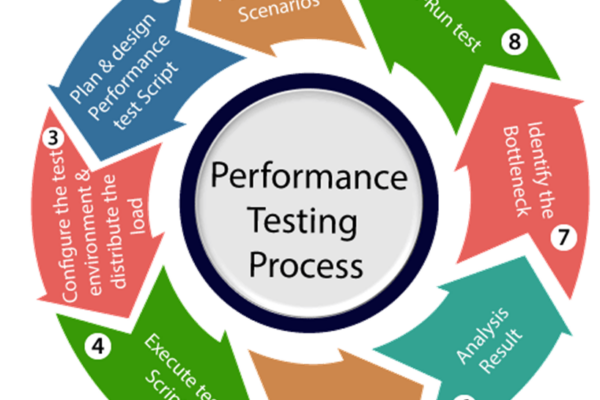
1. The Importance of Performance Testing
Key Benefits of Performance Testing:
2. Types of Performance Testing
2.4 Endurance Testing (Soak Testing)
2.6 Failover and Resilience Testing
3. Key Challenges in Modern Performance Testing
4. Modern Performance Testing Strategies
4.1 Shift-Left Performance Testing
4.2 Cloud-Based Performance Testing
4.3 API and Microservices Performance Testing
4.4 Real-User Simulation (RUM)
4.5 Performance Testing in DevOps Pipelines
5. Top Open-Source Performance Testing Tools
6. Interpreting Performance Test Results
Visualization & Analysis Tools:
7. Future Trends in Performance Testing
7.1 AI-Powered Performance Testing
7.2 Serverless Performance Testing
1. The Importance of Performance Testing
Key Benefits of Performance Testing:
2. Types of Performance Testing
2.4 Endurance Testing (Soak Testing)
2.6 Failover and Resilience Testing
3. Key Challenges in Modern Performance Testing
4. Modern Performance Testing Strategies
4.1 Shift-Left Performance Testing
4.2 Cloud-Based Performance Testing
4.3 API and Microservices Performance Testing
4.4 Real-User Simulation (RUM)
4.5 Performance Testing in DevOps Pipelines
5. Top Open-Source Performance Testing Tools
6. Interpreting Performance Test Results
Visualization & Analysis Tools:
7. Future Trends in Performance Testing
7.1 AI-Powered Performance Testing
7.2 Serverless Performance Testing
Performance testing has evolved significantly over the years, adapting to the fast-paced changes in technology, infrastructure, and user expectations. In the modern age, businesses must ensure their applications can handle high user loads

, offer seamless experiences, and maintain optimal performance across diverse environments. With the rise of cloud computing, microservices, and distributed architectures, traditional performance testing approaches need an upgrade.
This comprehensive guide explores the latest trends, tools, and best practices in performance testing, helping organizations build robust and scalable applications.
Performance testing assesses an application’s speed, scalability, and stability under varying conditions. It ensures that systems perform well under peak traffic, handle concurrent users efficiently, and remain reliable even during unexpected loads.
Assesses system performance under expected load conditions to determine if it meets performance requirements.
Use Case: Ensuring an e-commerce website can handle Black Friday traffic.
Evaluates system stability by pushing it beyond normal operating conditions to identify breaking points.
Use Case: Testing a banking system’s resilience under heavy transactional load.
Determines how efficiently an application scales by increasing workload and infrastructure resources.
Use Case: Checking if a SaaS application can handle growth from 10,000 to 100,000 users.
Measures system performance over an extended period to detect memory leaks and degradation.
Use Case: Assessing a streaming platform’s performance over a 24-hour continuous test.
Simulates sudden increases in user traffic to evaluate how the system responds to abrupt changes in demand.
Use Case: Analyzing how a social media app handles a viral trend.
Assesses how the system reacts to failures and ensures fault tolerance.
Use Case: Testing how a cloud-hosted database handles server crashes and failover mechanisms.
Traditionally, performance testing occurred late in the development cycle. Shift-left testing integrates it early, allowing developers to identify and resolve issues sooner.
Implementation:
Modern applications operate in the cloud, requiring testing that simulates real-world environments.
Cloud Testing Benefits:
Microservices architectures require testing at both the individual service level and the overall system level.
Best Practices:
Instead of relying solely on synthetic tests, Real-User Monitoring (RUM) gathers actual user data to identify performance bottlenecks.
Tools for RUM:
Integrating performance tests within CI/CD ensures continuous monitoring and optimization.
Approach:
After executing performance tests, it’s crucial to analyze the results effectively:
Artificial Intelligence (AI) is revolutionizing performance testing with predictive analytics, anomaly detection, and self-healing tests.
Testing serverless functions requires different approaches since execution is event-driven and ephemeral.
As edge computing grows, performance testing must evaluate latency and connectivity across distributed nodes.
With the rise of 5G, applications must be tested for ultra-low latency and high bandwidth scenarios.
Performance testing in the modern age is no longer a luxury—it’s a necessity. As applications become more complex, distributed, and cloud-native, organizations must adopt robust performance testing strategies to ensure speed, scalability, and reliability. By integrating testing into the development lifecycle, leveraging cloud-based solutions, and utilizing AI-driven insights, businesses can stay ahead of performance challenges and deliver seamless user experiences.
By adopting the best tools and practices, companies can create high-performing applications that not only meet but exceed user expectations. Whether you’re dealing with microservices, cloud deployments, or high-traffic applications, the principles of modern performance testing will help ensure the success of your digital initiatives.